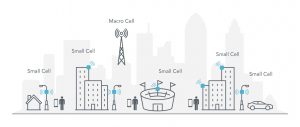Small Cells:

To expedite the roll-out of 5G, telecom operators in the country will leverage street furniture such as poles, advertisement hoardings and bus shelters for deploying low-power base stations called ‘small cells’ that will help bring the network closer to the consumers.
- Small cells are needed for deploying 5G as opposed to earlier generations such as 4G, because of the frequency.
- The higher the frequency, the lower the wavelength, which means that the distance they travel is less.
- Small cells are low-powered radio access nodes or base stations that have a coverage range from a few metres up to a few hundred metres.
- They are portable, easy to deploy and help provide localised coverage.
- As per the TRAI paper, small cells provide coverage for very short distances and therefore they are installed in a large number — even more than 200 per square kilometre — for good geographical coverage to provide highly reliable and high-capacity broadband.




